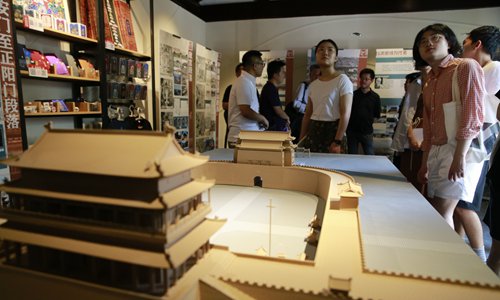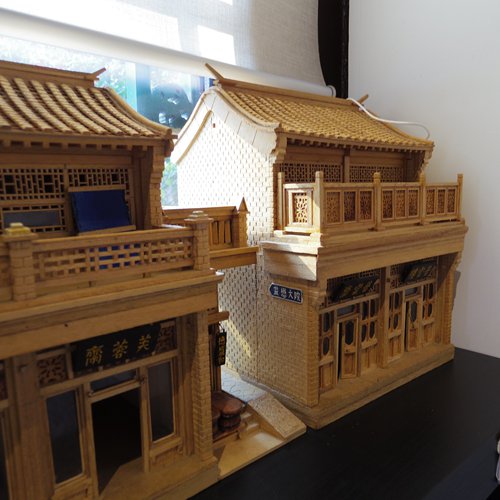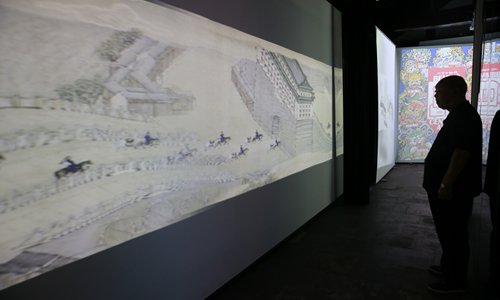HOME >> ARTS
Beijing’s historic Central Axis takes center focus at Beijing Design Week
By Bi Mengying Source:Global Times Published: 2019/9/5 17:50:18

Visitors explore the Central Emphasis exhibition at the Dongsi Hutong Museum in Beijing on Tuesday. Photo: Li Hao/GT

A model of the Yimao Courtyard on display at the exhibition Photo: Bi Mengying/GT

A couple pose with the model of the Yimao Courtyard at the exhibition on Tuesday. Photo: Bi Mengying/GT

Visitors at the exhibition on Tuesday Photo: Li Hao/GT
Beijing's history as the capital of China stretches back nearly eight centuries, while its history as a major urban hub stretches back more than three millennia. With this in mind, it comes as no surprise that the city boasts numerous historical sites, especially near core area of the old city, known as the Central Axis
Stretching for more than 7.8 kilometers, the famed Central Axis includes three UNESCO World Heritage Sites whose history that can be traced back to the Yuan Dynasty (1279-1368).
"The unique sublime and magnificent spatial order of Beijing was generated by this Central Axis," Liang Sicheng, the late pioneering Chinese architect and heritage preservation expert, once said.
An exhibition focusing on this region of the city, Central Emphasis kicked off on Tuesday as part of the annual Beijing Design Week, which officially started on Thursday.
Hub of history
The old city of Beijing was first built during the Yuan Dynasty and further developed during the Ming (1384-1644) and Qing dynasties (1644-1911). While the old city of Beijing holds a significant position in the world history of urban planning and development, it is the Central Axis that is the best preserved core area of the capital. It was inscribed to China's National Preparatory list in 2012. According to municipal authorities, the Central Axis will apply for World Heritage status in 2035.
Starting in the south at Yongding Gate and ending with the Drum Tower and Bell Tower in the north, the Central Axis ingeniously organizes the historic sites that were symmetrically constructed along it. In modern times, the axis was further extended again in 2003 as the city prepared for the 2008 Olympic Games.
Currently a total of 14 sites, including Qianmen, the Forbidden City, Jingshan Park, the Drum and Bell Towers, Chairman Mao Zedong Memorial Hall, the Monument to the People's Heroes and Tiananmen Square have been identified as key heritage sites.
Perfect platform
Running until October 31, the exhibition at the Dongsi Hutong Museum in Beijing showcases posters, models, photos and texts.
The museum itself shows a bit of the city's history as it is hidden in a hutong (a traditional narrow alley) in the neighborhood of Dongsi (East Four). Walking down the alley, all visitors can see are traditional doors, small shops and communal bathrooms. Inside one of these innocuous doors lies the museum.
Covering more than 1,000 square meters, it was located in a traditional courtyard built in the 1940s.
"The public's understanding about the Central Axis is still relatively limited... From the perspective of heritage, it can be considered as a site. Beyond the key heritage sites, it expands on both sides toward the east and west, including the streets, communities and the history and culture in these areas. Dongsi is one important representative. Because of the Central Axis, neighborhoods such as Dongsi and Xisi (West Four) came into being," Pang Shujing, director of the Planning Office at Tsinghua University's Culture Heritage Conservation Center (CHCC), told the Global Times.
"At the same time, the existence of these neighborhoods further reinforced the significance of the Central Axis in the larger picture."
Pang further pointed out that preservation of cultural heritage is a public cause that calls for the voices of both experts and the public.
"Beijing Design Week is an excellent platform. In our minds, design weeks mostly target professional groups, or young people or those who want to be fashionable. But Beijing Design Week can reach all groups of people. As you can see, there are senior people and kids at the exhibition here. The venues and events of the design week are spread across cities, where people both young and old live. The inclusiveness of the design week aligns with our goal to promote the culture of the Central Axis to the public," said Pang.
Focus on the future
Inside one exhibition hall, two elderly couples carefully observed a model of the Yimao Courtyard, a traditional residential building near the Central Axis.
"I specifically came to see the model. It was my home, where I used to live as a child. So many memories," said the senior gentleman, as he touched the model and looked at it with deep affection.
Passing on memories from one generation to the next is also one of the significance roles of the Central Axis, noted Pang.
"Yet we are not simply telling the history of the Central Axis, but also contemplating its future path and how it can contribute to people's lives today," said Pang.
"The length of a person's life cannot be compared to the length of history. The key is passing on heritage. There have been many people and organizations dedicated to preserving and protecting the Central Axis in the past and today. Even if its road to world heritage statues cannot be completed during my career, that is fine. The journey toward that goal is what matters the most," he noted.
Newspaper headline: Heart of the city